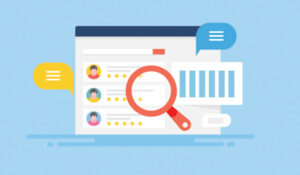Are your call centre agents really listening to what your customers are saying? By encouraging them to do so, they can pass on something really valuable to you – customer feedback. David Naylor reveals the steps you need to take.
Capture customer feedback and you can improve the service you offer while selling more. That’s the theory. But how many hours should you spend listening to customers’ calls or standing in a retail outlet handling customer objections, hearing them asking for the same things
they asked for last year? However many hours it is, there are two questions that you will have asked yourself time and again. Firstly, why don’t these obvious things that they are asking for get fixed? And secondly, how can I be in touch with what customers are saying now – not last month?
Most businesses find it hard to turn feedback in to practical improvements. They don’t act systematically on feedback. Why? Because their fixes are tactical rather than addressing the root causes.The keys to success are simple. To begin with, you need to ensure you capture actionable feedback. Next up, you need to make sure you get that data in real time. Historical data will not tell you what’s happening now and why. Lastly, you have to combine the voice of the customer (VoC) from across the whole business to ensure the management team are all acting on the same priority issues.
What is the best feedback?
Offering up ‘keys to success’ is all well and good. But if we go back to step one – ensuring you capture actionable feedback – just how should you do this? You could say that any feedback is good feedback, but it needs to be actionable, accurate and relevant.
Two commonly used sources of feedback are:
- Post contact surveys, conducted immediately after the interaction a customer has had with a representative. “Did you get your issue resolved?” is a common question. This feedback is useful for targeting performance improvements in individuals and monitoring quality. It is very tactical and structured feedback, but tells you what you need to run the operation more effectively for you, rather than for the customer.
- Regular surveys to the customer base to check levels of satisfaction and gather feedback, asking “how can we improve?”. As these surveys happen quarterly or even annually they are considered to be useful in feeding the strategic planning of the business. Unfortunately, the responses are given too long after any interaction has taken place so are uninformative and out-of-date.
As we can see from these examples, a big problem for many businesses is that a high percentage of their VoC activity is wasted effort or of limited value. Managers fail to harness the power of what their customers and front line staff are saying at the time they are saying it.
We call the process of gathering and acting systematically on customer feedback via the front line, ‘WOCAS’ or ‘what our customers are saying’. WOCAS checks the boxes on the key success factors mentioned above because:
1) Front line staff must deal with the same customer frustrations, day in day out.
They know how to solve the problems or can see what needs changing to make the process better for the customer and the business. Whether customers actually express their frustrations or not, the front line staff know the issues and can log them.
2) The information is truly real time.
As soon as new issues emerge, the front line will be the first to spot them. Feeding that knowledge in to a process where it can be acted on as quickly as possible is important.
3) The front line is not just the call centre.
It could be the retail stores, field sales reps. or the repair centre teams. Having the right quantity of feedback to make it meaningful is critical. Feedback can be captured from all these areas in a consistent way and aggregated to give the management team real and representative data on which to base decisions.
Gathering feedback through the front line is just the start of the WOCAS process. Acting systematically on the data is the next critical step. Why? Because you need to aggregate the frustrations and suggestions; prioritise these aggregated issues in order of importance; track that issues have been valued, prioritised and set out for action; assign business owners to
drive actions; and communicate what’s happened to the business, specifically closing the loop with the front line.
Benefits for all
| How the WOCAS process worksWOCAS creates a closed loop from the front line, through issue root cause owners back to the operation where customers and staff feel the improvement. Staff can log the feedback they hear from customers as a ‘voice’. Voices are aggregated by a voice analyst to form ‘issues’ and weighted to prioritise these issues. Issues are assigned to ‘business owners’ to fix and track to resolution. Communication back to staff is made easy so business owners are connected to the front line and vice versa. WOCAS encourages staff to submit feedback since they can track what action has been taken all the way through to implementation. WOCAS supports the process to deliver root causes for customer contact. |
Once you have established the right feedback mechanism, the process can be used to deliver benefits across the business, not just in the traditional service arena, as shown by the four examples below:
Benefit 1: Improving sales campaigns
Real time feedback can be captured from sales campaigns. This allows you to manage objections, amend offers and improve results before the historical results come through.
A bank spends tens of millions advertising an online banking account with great terms. It advertises a web address and a phone number for campaign response. Customers ring up and say: “Please e-mail me something on it”, but the staff have no e-mail capability. Customers go on the web and look for assistance, but the person on the number they call doesn’t know about
the offer. The customer thinks “This is a ‘dumb’ bank because it has an online account, but I can’t use e-mail, and it offers products but no service”.
No one member of staff can get these problems sorted, but if many members of staff report the problem – if your
management systematically listens and knows how much of a priority (or not) this is to winning sales – then it can be fixed.
Benefit 2: Taking feedback to the top
WOCAS was an original concept used by Budd’s LimeBridge partner Bill Price from Driva Solutions. When Bill was the global customer service director at Amazon, he began to engage the whole business in WOCAS. Realising the power of verbatim, he asked each team leader to submit a WOCAS report. He shared the reports across departments at the senior
level and with the CEO.
The result was – and is – more engagement at all levels with customer issues. The board is able to cut through the fog of other detailed management reports and just see instantly whether process improvements are working.
Benefit 3: Removing root causes of customer service frustrations
Listening to feedback in customer services is always very revealing because it shows you the number of customers’ issues that are caused by actions in other parts of the business and not in customer service. Using a WOCAS process to capture feedback will enable you to track which areas of the business are causing problems and generate sufficient data to show the relevant business owners the scale of the problems being created. Without the data, fixes are at best tactical and at worst ‘workarounds’.
Presenting both qualitative and quantitative data is essential. It’s about knowing what’s happening, why it’s happening, how often and what the impact on customer satisfaction will be as a result. The more front line staff that log an issue, the greater the assessment of the impact will be. Armed with this information, agreements are much easier to achieve. Joint
priorities can be set to fix cross-departmental problems and so optimise the use of scarce-shared project resources.
Benefit 4: Marketing, product and process designers can spend less and get more
Gathering information for marketing, product and service design in real time through a WOCAS process is highly attractive. Rather than expensive focus groups run by third parties, front line representatives can do the same job in house at a fraction of the cost. Not only that, but there’s a major benefit in being able to access the information in
real time rather than waiting weeks for an external agency’s research or focus group report.
Think of the following scenario as an example: a company has introduced a new interactive voice response (IVR) system for a certain segment of its customers. The system reports tell them what routes people followed through the menus but it’s hard to capture whether the experience was an improvement and if they understood the process. Using WOCAS, immediate feedback can be solicited from callers by the front line and aggregated to give an accurate understanding. Identifying the fact that people don’t understand all the menu options, means that changes can be made the same day – and something done about it immediately.
Being able to test the impact of changes and ideas very quickly and at low cost means the business can learn faster what works and stay ahead of the curve in marketing and product design for less investment.
Check your VoC approach
How many companies beyond Amazon are using the WOCAS process? In our experience, many have hot issues processes, voice of customer processes, and so on. Few are real time and actionable. Few can cope with more than a handful of suggestions at once. None allow senior management to see the overall picture, set priorities and follow them through. Seldom are the suggestions tracked and successes communicated fully.
Imagine how useful it would be if you had up-to-the minute access on your desk to what your customers are saying, their
frustrations, their suggestions, their observations – and a way to ensure that this information is aggregated, analysed and made available to senior managers who can drive action to make sure the right things get fixed fast. The WOCAS process gives this power to managers in applications across organisations. Everyone can get real benefits from customer feedback.

David Naylor is a director of Budd in the UK, a member of the LimeBridge alliance, which operates in 11 countriesTel: +44 7855 806189
Website: www.budd.uk.com
Author: Jonty Pearce
Published On: 27th Sep 2006 - Last modified: 2nd Mar 2020
Read more about - Customer Service Strategy, Customer Surveys
















This is a first class article and it echoes my own experience.
After trying many different ways to raise customer satisfaction I found that the most dramatic results, by far, were by taking customer comments, showing them to everyone in the company, acting on them swiftly & appropriately and closing the loop by letting staff and customers know the outcome.
The process does need to be systematic, so that customers experience it consistently, and everyone in the company needs to understand their roles and responsibilities and how to participate.